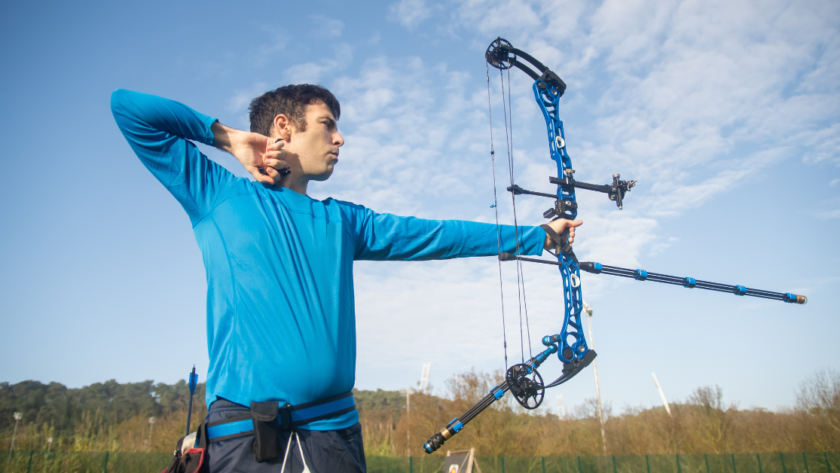As an archer with decades of experience, I’ve seen firsthand how proper posture can transform an average shooter into a precision marksman.
Mastering archery posture is crucial for anyone serious about improving their performance.
Let’s take a look at the foundations, biomechanics, and advanced techniques that will elevate your archery game.
The Foundations of Archery Posture
The ideal stance in archery, known as the T-form, serves as the cornerstone of a stable and repeatable shooting platform. To achieve this:
- Position your feet shoulder-width apart, perpendicular to the shooting line.
- Maintain a straight spine, perpendicular to the ground.
- Align your shoulders with the target.
- Extend your bow arm towards the target without locking the elbow.
- Draw your string hand to your anchor point, forming a right angle with your draw arm at full draw.
This T-form allows for optimal energy transfer from your body to the bow and ultimately to the arrow. It’s not just aesthetically pleasing – it’s biomechanically efficient.
The Biomechanics Behind the Form
Understanding the underlying mechanics of proper posture helps internalize and maintain it. Let’s break down the key components:
Skeletal Alignment
Your skeleton acts as the framework supporting every movement. When properly aligned, it functions like a well-engineered bridge, efficiently transferring force from the ground up through your body and into the bow.
This alignment minimizes muscular effort and reduces fatigue, allowing for more consistent shooting over extended periods.
Muscular Engagement
While skeletal alignment provides the structure, your muscles supply the power and control. The primary muscle groups in archery include:
- Back muscles (particularly the rhomboids and trapezius)
- Core muscles
- Shoulder stabilizers
Proper engagement of these muscles enhances shot execution and protects against injury. Focus on activating these muscle groups during your draw and hold.
Kinetic Chain
In archery, your body functions as a single unit, with energy flowing from the ground through your legs, core, and arms.
This is known as the kinetic chain. Any break in this chain – such as leaning back or collapsing your bow arm – can lead to inconsistent shots and reduced power.
Common Postural Pitfalls and Their Solutions
Even experienced archers can develop bad habits. Here are some frequent posture problems I’ve encountered and how to address them:
Bow Arm Collapse
Problem: The bow arm bends upon release, causing inconsistent arrow flight.
Solution: Maintain a straight (but not locked) bow arm throughout the shot. Strengthen your triceps and shoulder muscles with exercises like push-ups and planks.
Practice holding your bow at full draw for extended periods to build endurance.
Inconsistent Anchor Point
Problem: The draw hand doesn’t come to the same spot on your face each time.
Solution: Develop a consistent anchor point using tactile references on your face. For example, touch your index finger to the corner of your mouth or your thumb to your jawbone.
Practice this anchor point without an arrow, focusing solely on the feeling and position.
Leaning Back
Problem: The upper body leans backward to compensate for draw weight.
Solution: Engage your core muscles and focus on keeping your spine vertical. Practice with a lighter bow until you can maintain proper form.
Gradually increase the draw weight as your strength and technique improve.
Shoulder Hunching
Problem: Shoulders rise towards the ears, creating tension and inconsistency.
Solution: Consciously relax your shoulders before and during the draw. Practice shoulder rolls between shots to release tension.
Incorporate shoulder mobility exercises into your warm-up routine.
The Core of the Matter: Strengthening Your Foundation
A strong core is essential for maintaining proper archery posture. This involves developing the deep stabilizing muscles that keep your spine aligned and your body balanced. Here are some exercises I recommend to my students:
- Planks: Hold for 30-60 seconds, focusing on keeping your body in a straight line.
Gradually increase duration as you build strength.
- Russian Twists: Sit on the floor, lean back slightly, and rotate your torso from side to side.
Use a weight for added resistance.
- Bird Dogs: On hands and knees, extend opposite arm and leg while maintaining a neutral spine.
Hold for 5-10 seconds per side.
- Dead Bugs: Lie on your back with arms extended towards the ceiling and legs in a tabletop position.
Lower opposite arm and leg while maintaining core engagement.
- Pallof Press: Using a resistance band, press your arms straight out in front of you while resisting rotation.
This exercise targets the obliques and transverse abdominis.
Incorporate these exercises into your routine 2-3 times a week, and you’ll notice improved stability and endurance in your shooting.
Adapting Posture Across Disciplines
While the fundamentals of good posture remain constant, different archery disciplines may need slight variations:
Olympic Recurve
This style emphasizes an open stance with precise alignment. The bow arm is typically held slightly higher to accommodate the sight and stabilizer setup.
Focus on maintaining a consistent draw length and anchor point.
Compound
Compound archery often uses a more closed stance to work with release aids. The draw length is usually shorter, requiring a slightly different shoulder alignment.
Pay attention to your release technique and follow-through.
Traditional
Traditional archery may involve a more dynamic posture, especially in instinctive shooting. The draw is often to the ear as opposed to the chin, changing the anchor point and upper body alignment.
Emphasize fluidity and natural body positioning.
Remember, these are general guidelines. The key is to find what works best for your body and shooting style while maintaining the core principles of good posture.
The Mental Game of Posture
Maintaining proper posture isn’t just a physical challenge – it’s a mental one too. Here are some strategies to keep your mind as aligned as your body:
- Develop a pre-shot routine that includes a posture check.
This could involve a quick mental scan of your body from feet to head.
- Use visualization techniques to reinforce proper form.
Spend time each day imagining yourself executing perfect shots with flawless posture.
- Practice mindfulness to stay aware of your body position throughout the shot.
Focus on the sensations in your muscles and joints as you draw and release.
- Set specific posture-related goals for each practice session.
For example, “Maintain a relaxed bow shoulder for 90% of my shots today.”
- Use positive self-talk to reinforce good habits.
Replace negative thoughts like “Don’t collapse your bow arm” with positive affirmations like “I maintain a strong, stable bow arm.”
By making posture a conscious focus, you’ll develop the muscle memory needed for consistent form under pressure.
Cutting-Edge Research in Archery Biomechanics
Recent studies have shed new light on the importance of posture in archery:
- 3D Motion Capture Analysis: Research using advanced motion capture technology has revealed that elite archers maintain more consistent posture throughout the shot cycle compared to novices.
This consistency extends to minute movements of the fingers and wrist during release.
- EMG Studies: Electromyography (EMG) studies show precise muscle activation patterns during the shot, highlighting the importance of engaging the right muscles at the right time.
These studies have identified key differences in muscle recruitment between expert and novice archers.
- Fatigue Analysis: Research shows that maintaining proper posture becomes increasingly challenging during long competitions, emphasizing the need for postural endurance training.
Studies have shown a correlation between postural fatigue and decreased accuracy in the later rounds of competitions.
- Biomechanical Modeling: Advanced computer modeling of the archery shot has allowed researchers to identify optimal joint angles and body positions for most efficiency and accuracy.
- Eye Tracking Studies: Research using eye-tracking technology has revealed how expert archers maintain visual focus and alignment throughout the shot process, contributing to their postural stability.
These findings underscore the need for archers to practice their technique and to engage in targeted strength and conditioning to support proper posture.
Injury Prevention Through Proper Posture
One of the most compelling reasons to perfect your archery posture is injury prevention. Common archery-related injuries often stem from poor form:
- Rotator Cuff Strains: Improper shoulder alignment can lead to overuse injuries in the rotator cuff muscles. Maintain proper shoulder position and avoid overreaching during the draw.
- Lower Back Pain: Leaning or twisting during the shot can strain the lower back muscles. Focus on maintaining a neutral spine and engaging your core throughout the shot process.
- Repetitive Strain Injuries in the Bow Arm: Collapsing or hyperextending the bow arm can lead to tendonitis or other overuse injuries. Work on maintaining a consistent, slightly bent bow arm position.
- Neck Strain: Improper head position or excessive tension in the neck can lead to pain and stiffness. Keep your head in a neutral position, aligned with your spine.
- Finger and Wrist Injuries: Improper grip or release technique can cause strain on the fingers and wrist. Focus on a relaxed bow hand and smooth release.
By maintaining proper posture, you distribute stress evenly across your body, reducing the risk of overuse injuries and allowing for a longer, more enjoyable archery career.
Exercises to Reinforce Proper Posture
To help you internalize fix posture, try these exercises:
- Mirror Practice: Draw your bow in front of a mirror, focusing on achieving perfect T-form.
Pay attention to your shoulder alignment, spine position, and overall symmetry.
- Blind Drawing: Close your eyes and draw your bow, then have a partner check your form.
This exercise enhances proprioception and body awareness.
- Wall Drill: Stand with your back against a wall and practice your draw, ensuring your shoulders and hips stay in contact with the wall.
This helps reinforce proper spine alignment.
- Balance Board Training: Practice your stance on a balance board to improve proprioception and stability.
Start with both feet on the board, then progress to single-leg balance as you improve.
- Resistance Band Draw: Use a resistance band to simulate the draw of your bow.
Focus on engaging the fix muscle groups and maintaining proper alignment throughout the movement.
- Posture Hold: Hold your full draw position for extended periods (10-30 seconds) without an arrow.
This builds endurance in the muscles responsible for maintaining proper form.
- Video Analysis: Record yourself shooting and review the footage in slow motion.
Look for any deviations from ideal posture and make notes for improvement.
Incorporate these drills into your regular practice routine to build muscle memory and improve your overall form.
Advanced Postural Techniques for Competitive Archers
For those looking to take their archery to the next level, consider these advanced postural techniques:
- Micro-Adjustments: Learn to make tiny adjustments to your posture during the aiming phase without disturbing your overall form.
This skill allows for fine-tuning your aim without compromising stability.
- Dynamic Stability: Practice shooting in various conditions (wind, uneven terrain) to develop the ability to maintain proper posture even when external factors are challenging your balance.
- Breath Control: Integrate advanced breathing techniques into your shot sequence to enhance stability and reduce tension.
Experiment with different breathing patterns to find what works best for you.
- Mental Imagery: Use detailed mental rehearsal to reinforce perfect posture.
Visualize not just the external form, and the internal sensations of proper alignment and muscle engagement.
- Biofeedback Training: Utilize biofeedback devices to gain real-time information about muscle tension and body position.
This can help you identify and fix subtle postural issues.
- Cross-Training: Incorporate complementary activities like yoga or Pilates to enhance overall body awareness, flexibility, and core strength.
- Periodization: Develop a training plan that cycles through different aspects of posture and form, allowing for focused improvement in specific areas while maintaining overall skill.
The Role of Equipment in Supporting Proper Posture
While good posture primarily comes from the archer, equipment can play a supporting role:
- Bow Fit: Ensure your bow is properly sized and adjusted for your body.
An ill-fitting bow can force you into poor posture.
- Stabilizers: Experiment with different stabilizer setups to find a balance that supports your natural posture and shooting style.
- Release Aids: For compound archers, choose a release aid that allows for a comfortable and consistent anchor point.
- Archery-Specific Clothing: Wear clothing that allows for full range of motion without restricting movement or interfering with your form.
- Customized Grips: Consider using a custom grip or modifying your bow grip to better fit your hand, promoting a relaxed and consistent bow hand position.
Remember, equipment should enhance your natural form, not force you into an unnatural posture.
Frequently Asked Questions
What is the fix posture for archery?
The fix archery posture involves standing perpendicular to the target with feet shoulder-width apart, maintaining a straight spine, and forming a T-shape with your arms at full draw. Your body should be relaxed yet stable, with your core engaged and shoulders aligned.
How can I improve my archery stance?
To improve your archery stance, focus on developing core strength, practice balance exercises, and regularly perform posture-specific drills. Video analysis and working with a coach can help identify areas for improvement.
What muscles are used in archery posture?
The primary muscles used in archery posture include the back muscles (trapezius, rhomboids, and latissimus dorsi), core muscles (abdominals and obliques), shoulder muscles (deltoids and rotator cuff), and leg muscles for stability.
How do I prevent back pain in archery?
Prevent back pain in archery by maintaining proper spinal alignment, engaging your core muscles, and avoiding overarching or twisting during the shot. Regular stretching and strengthening exercises for the back and core can also help.
What is the best anchor point for archery?
The best anchor point varies depending on your shooting style and facial structure. Common anchor points include the corner of the mouth, under the chin, or along the jawline.
Consistency is key – choose an anchor point that you can copy reliably.
How do I stop my bow arm from shaking?
To reduce bow arm shake, focus on relaxing your bow hand and arm, engage your back muscles to support the draw, and practice holding at full draw to build endurance. Strengthening exercises for the arms and shoulders can also help improve stability.
What is the proper follow-through in archery?
Proper follow-through in archery involves maintaining your posture and aim even after the arrow has left the bow. Your bow arm should remain steady, and your release hand should move straight back along your jaw or neck.
How important is breathing in archery posture?
Breathing is crucial in archery posture. Proper breath control helps maintain stability and reduces tension.
Many archers use a technique of exhaling half their breath before reaching full draw and then holding their breath during the aim and release.
Can poor posture affect archery accuracy?
Yes, poor posture can significantly affect archery accuracy. Inconsistent or improper posture can lead to variations in draw length, anchor point, and release, all of which impact arrow flight and precision.
How long does it take to develop good archery posture?
Developing good archery posture is an ongoing process, but with consistent practice, most archers see significant improvements within 3-6 months. However, refining and maintaining proper posture is a lifelong aspect of archery training.
Key Takeaways
- Proper archery posture is basic to accuracy, consistency, and injury prevention.
- The T-form provides a stable, effective platform for shooting.
- Understanding biomechanics helps internalize fix form.
- Common postural issues can be corrected with targeted exercises and mindful practice.
- Core strength is crucial for maintaining good posture throughout a shooting session.
- Mental focus and pre-shot routines help maintain consistent form.
- Ongoing research in archery biomechanics continues to refine our understanding of optimal posture.
- Adapting posture across different archery disciplines needs subtle adjustments while maintaining core principles.
- Advanced postural techniques can give competitive archers an edge in performance.
- Equipment should support and enhance natural posture, not force unnatural positions.



